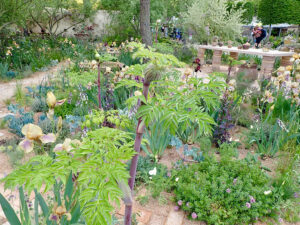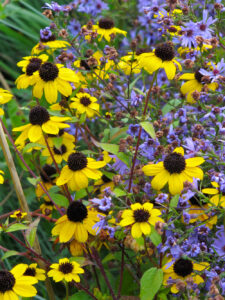When you’re obsessed with plants, as I definitely am, there’s a tendency to want to grow as many different things as you cram in. You see something lovely and then you take it home, like a trophy. Your Best Beloved ruins it by saying – where’s that going to go. And one day, ladies, he will get the answer he deserves! I find room for my treasure in an already overcrowded garden, but there’s a backbone to my borders created by weaving several of the same plant through the others. It helps to avoid the dot-to-dot painting effect plantaholics tend to suffer from.
I learnt this ‘repetition’ technique from the late Beth Chatto who died in 2014 aged 94. She gardened and ran a nursery at Elmstead Market near Colchester in Essex. Part of her garden, in this dry east anglian county, was arid but she also had woodland and spring-fed moister soil, so she grew a wider range of plants than most. I wrote about Beth in my May blog entitled Develop a Flower Arranger’s Eye. Her good work is carried on by her granddaughter Julia Boulton and The Beth Chatto Garden continues to inspire if you visit. The mail order plants are also excellent.

What raised Beth above most gardeners was her artistic eye, which was helped along by her friendship with the painter Sir Cedric Morris of Benton End in Hadleigh in Suffolk. This year’s Chelsea Flower Show displayed some of Morris’s ‘painterly’ irises in shades of blue, brown and olive in Sarah Price’s Gold Medal winning garden. I fell in love with ‘Benton Olive’ and managed to acquire some of this pale-blue, muted olive-green and brown beauty from Wootten’s Plants. They, along with the Beth Chatto Nursery, sell some of Cedric’s irises. ‘Benton Nigel’ is a rich purple-blue that does well here. It’s the most available of all and well worth a place in anyone’s garden.
Sir Cedric named 95 irises in all, mostly after friends or his pet menagerie, but many of them disappeared following his passing in 1982. They may have remained lost forever, if retired Head Gardener Sarah Cook hadn’t started to rescue them. There is an excellent article by Barbara Segall, entitled Sarah Cook’s Search for Cedric Morris Irises, on the Garden Museum website, posted this May. It will explain much more.
Beth used yellow, a colour she described as ‘the spinning thread’, to unite her planting schemes. Yellow comes in cooler shades of lemon and lime and this colour mixes well with equally cool-toned blues and purples. Warmer yellows have golden tones and they mix best with warm reds and oranges. The two hues, warm and cool, don’t mix well together and this also applies to pink. Thankfully, the seasons separate the yellows, with early-flowering cool hues coming before the late-summer and autumnal golden yellows.
In spring the pale-lemon wood anemone, Anemone x lipsiensis, pops up through my too many-by-far hellebores! This diminutive anemone lights up the ground, without being too invasive. When there’s an X in any plant name, it denotes a hybrid between two species. Hybrids tend to have more vigour than their parents. However, this refined woodland anemone has a far more thuggish, brash-yellow parent named A. ranunculoides. This can invade you and involve you in a lot of spade work. The other parent is the wood anemone, A. nemorosa. These woodland anemones disappear after flowering,
The cupped and nodding flowers of the wood anemones should not be confused with the sun-loving Anemone blanda, which has an upward facing flower with straight ray petals. These demand a sunny position, not shadier spots.
Once May arrives there are two anthemis of note. The earliest pale-yellow daisy is Anthemis ‘Susanna Mitchell’ and this short anthemis has a curtseying habit and fine silvery foliage derived from one parent, the white-flowered, low-growing A.cupaniana. The other parent is A. tinctoria, a straight-stemmed yellow daisy. ‘Susanna Mitchell’, which appeared as a seedling in this lady’s garden, pops up along the front of my rose and peony borders close to the purple wallflower ‘Bowles’s Mauve’. Both pre-empt the peonies and roses.

I’m also a fan of Anthemis ‘E.C. Buxton’ which Beth always said was one her best ten garden plants. This weaves it way up the path towards the front door and the flowers can last for weeks – like a series of spinning plates. My midsummer the subtle-yellow wave continues with hemerocallis, or daylilies.
The most readily available is the tasteful, clear-yellow ‘Whichford, raised by Harry Randall in 1960. Randall, the first chairman of the London Electricity Board, preferred irises in truth. He also raised hemerocallis and named them after places. There is pink called ‘Stoke Poges’ and a red named ‘Stafford’, both worth growing. ‘Whichford’ is fragrant and fairly tall, with strong stems containing several flowers that open in stages, so you get 3 weeks of flower. ‘Marion Vaughan’ looks a good one too, raised by Smith in 1951.
By the time ‘Whichford’ is in flower the tall willowy Ratabida pinnata is producing its droopy-petalled daisies held way above the foliage. It’s not often seen in gardens, because this five-foot high plant doesn’t shine on the garden centre bench even if you can keep it upright. It’s one of those plants that you have to get established before winter arrives. The common names are pinnate prairie coneflower, gray-head coneflower, yellow coneflower, and prairie coneflower. It is native to the central and eastern United States and Ontario in Canada and it’s fully hardy once the roots get down. Winter wet may not suit it however.
Warm yellows are on the scene by mid-July and the first arrival is one of my all-time favourites, although the name is an impossible mouthful! Heliopsis helianthoides var. scabra ‘Summer Nights’ has a red middle in the centre of teach yellow daisy and it ignites the midsummer border. Just remember Summer Nights, the popular song from Grease instead.
The tall rudbeckia ‘Herbstonne’ isn’t far behind in the time line and this upright, tall yellow daisy has strong stems topped by swooning mid-yellow daisies with green thimble-like middles. Beth described them as knobs. I love happy accidents and the double-flowered dusky damson viticella clematis, ‘Purpurea Plena Elegans’ has woven itself through my ‘Herbstonne’. It’s meant to be climbing up the summerhouse, but nature came up with a much better solution for me. The German name, by the way, translates as ‘Autumn Sun’.

Lower down the height scale comes the best Black-eyed Susan of all, Rudbeckia fulgida var. deamii or Deam’s coneflower. There are several forms of but this one has the best foliage and the neatest flowers, a crisp mixture of warm-yellow and brown velvet. This is another of the very best perennials and slightly taller than most forms too. I saw this mass-planted in John Massey’s private garden at Ashwood Nurseries (open every Saturday – check the website) and it shone out at the front of a late-summer border. Beth Chatto has the correct plant, raised by division and not from seed.
By September another rudbeckia named ‘Henry Eilers’ is also in flower. This upright plant has mid-sized orange-yellow spoonbill petals and it was a chance discovery by a railway line in Southern Illinois – presumably by Henry Eilers. This si found in central states of the United States and it was unfazed by last year’s hot, dry summer. Another coloniser of railway lines is Rudbeckia triloba, only this is found in central and eastern united states.
It’s one of those plants that flowers itself to death, so it tends to be short-lived. However, it will still be in flower in November – the last daisy standing. ‘Prairie Glow’, which has orange petals tipped in yellow, is ubiquitous suggesting that it’s being seed-raised in numbers perhaps. It isn’t as light and airy, so I’m not keen. You may feel differently!



